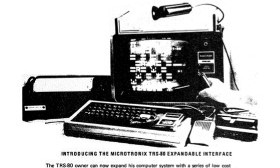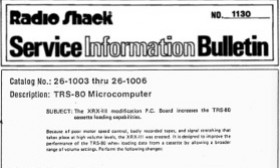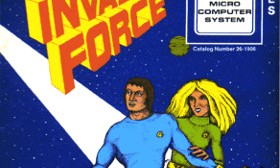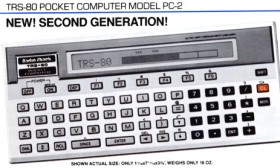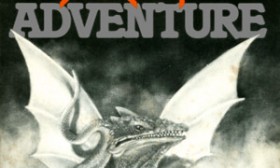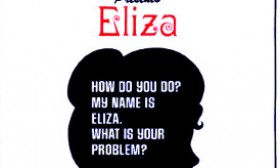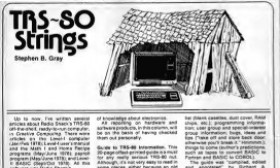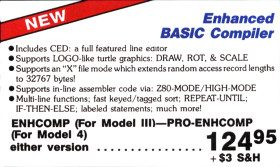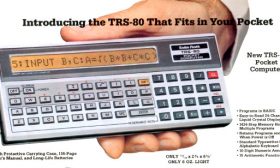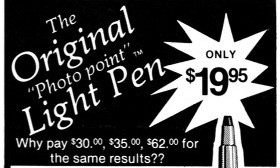The Microtronix Expandable Interface was probably the first third-party alternative to the Radio Shack Expansion Interface for the TRS-80 Model I. It cost $129.95 when it was introduced in late 1978 by Microtronix of Philadelphia, Pennsylvania. According to the product announcement in H&E Computronics, the Expandable Interface was also available in kit form for around $100.00.
Microtronix sold software and hardware for the TRS-80 (as well as the Apple II and Commodore PET), including the Electric Pencil lowercase modification and a 16K RAM expansion. They demonstrated the Expandable Interface at the Personal Computing ‘78 show, which was held in 1978 in Philadelphia from August 25th to 27th. The Expandable Interface had an unusual set of features:
(Read more...)
The XRX was an official hardware modification from Radio Shack for the TRS-80 Model I. It installed inside the Model I and made it easier to load programs from cassette using Level II BASIC. Radio Shack dealers would install the XRX for free on any unmodified Model I. (For owners with a modified Model I, the installation price could range from $30.00 to $50.00.) Model I’s built after the XRX was introduced included it as a standard feature.
The original version of the modification, usually called the XRX or XRX-1, was introduced in early 1979. At the time, Radio Shack only called it “the modification.” Because it wasn’t a named product with a catalog number, it was known by many names by users, including XRX, XRX-I, XRX-II, XRX-III, XRX2, XRX3, XRS-2, and X2X. These were all different names for the same modification.
(Read more...)
Invasion Force (catalog number 26-1906) was one of the first action games Radio Shack published for the TRS-80 Model I. It was written by Robert Arnstein and introduced in 1979 on cassette for a price of $14.95. There never was a disk version of Invasion Force.
Invasion Force was very similar to Trek-80, a game for the Sol-20 computer that was probably also written by Robert Arnstein. Here is a description of Invasion Force from an article titled “A New Real-Time Space Adventure That Puts You in Command of Your Own Starship” from the June 1979 issue of the TRS-80 Microcomputer News:
Take command of the USS Hephaestus and protect the galaxy against the hated and feared Jovians. The Command Control Display (TRS-80 screen) places all the ship’s resources at your fingertips.
(Read more...)
The TRS-80 Pocket Computer 2 (catalog number 26-3601), better known as the PC-2 (and even the Pocket Computer II in some early articles), was the most powerful member of Radio Shack’s family of Pocket Computers. The PC-2 wasn’t a replacement for the original Pocket Computer (known as the PC-1), but served as a more advanced (and more expensive) alternative.
The PC-2 cost $279.95 when it was introduced in 1982, but that price dropped to $199.95 by the following year. It was the only Pocket Computer that had speed and memory capacity that was competitive with a contemporary desktop computer. The PC-2 wasn’t manufactured by Radio Shack, but was a rebadged Sharp PC-1500. It wasn’t compatible with any of the hardware or software Radio Shack sold for the PC-1.
The PC-2 was larger and heavier than the PC-1. It measured 7 11/16" by 3 1/8" by 1 1/16", nearly one inch bigger in each dimension than the PC-1. It weighed 16 ounces (with batteries) compared to the six ounces of a PC-1.
(Read more...)
Microsoft Adventure, introduced in December 1979, was the first game sold by Microsoft, Inc., which at the time was located in Bellevue, Washington. It was written by Gordon Letwin and was among the first four products sold by Microsoft Consumer Products, a new division created to sell software to consumers. Before that point, Microsoft primarily sold BASIC interpreters (such as TRS-80 Level II BASIC) directly to manufacturers. Microsoft Adventure cost $29.95 and was available for the TRS-80 Model I and the Apple II when it was released in 1979. It had unusually high system requirements for a game at the time; both the Model I and Apple II versions required 32K and a floppy drive.
Microsoft Adventure was a microcomputer adaptation of Adventure, also known as Colossal Cave or ADVENT, which was first written for the DEC PDP-10. Adventure was the first computer adventure game and became very popular on mainframe installations in 1977 and 1978.
(Read more...)
Eliza (catalog number 26-1908), also known as Talking Eliza, was a TRS-80 Model I and Model III implementation of Dr. Joseph Weizenbaum’s famous ELIZA program. It was introduced by Radio Shack in 1979 for a price of $14.95. Eliza was written by Robert A. Arnstein and was licensed to Radio Shack through his company, Device Oriented Games. One unusual feature of the program was its ability to speak its responses using Radio Shack’s TRS-80 Voice Synthesizer, hence the name Talking Eliza.
The original ELIZA program was created by Dr. Joseph Weizenbaum. He described it in an article “ELIZA – A Computer Program For the Study of Natural Language Communication Between Man and Machine” that was published in the Communications of the ACM in January 1966:
(Read more...)
“TRS‑80 Strings,” later known as “Tandy Gram,” was a column in Creative Computing magazine that focused on TRS-80 computers. It was written by Stephen B. Gray for most of its run and first appeared in the November/December 1978 issue.
Stephen B. Gray was best known for founding the Amateur Computer Society in 1966, a group for “anyone interested in building and operating a digital computer that will at least perform automatic multiplication and division.” Gray was also the publisher of the newsletter for the Amateur Computer Society (better known as the ACS Newsletter) that claimed to be (and probably was) “the first hobby-computer publication in the world.” The ACS Newsletter published 40 issues from August 1966 to December 1976.
(Read more...)
EnhComp was a BASIC compiler written by Philip Oliver for the TRS-80 Model III and Model 4. (Longtime TRS-80 users probably remember Philip Oliver for his excellent game
Scarfman.) Oliver wrote two versions of EnhComp: the original published by the Cornsoft Group of Indianapolis, Indiana in 1980 and the more popular second version (whose full name was the Enhanced BASIC Compiler Development System) sold by MISOSYS of Sterling, Virginia starting in 1986. Unlike most other TRS-80 BASIC compilers (such as Simutek’s ZBASIC), EnhComp wasn’t primarily focused on compatibility with interpreted BASIC but on providing a new enhanced version of BASIC.
(Read more...)
The TRS-80 Pocket Computer (catalog number 26-3501) was the first in Radio Shack’s line of pocket computers. It cost $249.00 when it was introduced on July 31, 1980, the same day as the TRS-80 Model III and the TRS-80 Color Computer. The Pocket Computer was renamed the PC-1 in 1982 after the PC-2 was introduced.
Unlike their other computers (the Model I, Model II, Model III, and Color Computer), the Pocket Computer wasn’t a Radio Shack design. It was actually a rebadged Sharp PC-1211, which had been introduced in Japan the same year. (At the time, the PC-1211 wasn’t available in the United States.)
(Read more...)
The Photopoint was a popular light pen for the TRS-80 Model I and Model III. It cost $19.95 and was sold by Micro Matrix of Pacifica, California. Although virtually unknown today, light pens were once considered the way of the future to select items on a computer screen. The Photopoint was much less expensive than competing products when it was introduced around 1980 (some of which cost hundreds of dollars) and provided a way to experiment with light pen technology.
Light pens at the time worked using two approaches. The first was to detect the screen refresh. All CRT displays refresh the screen by continually scanning a beam from left to right and top to bottom.
(Read more...)
